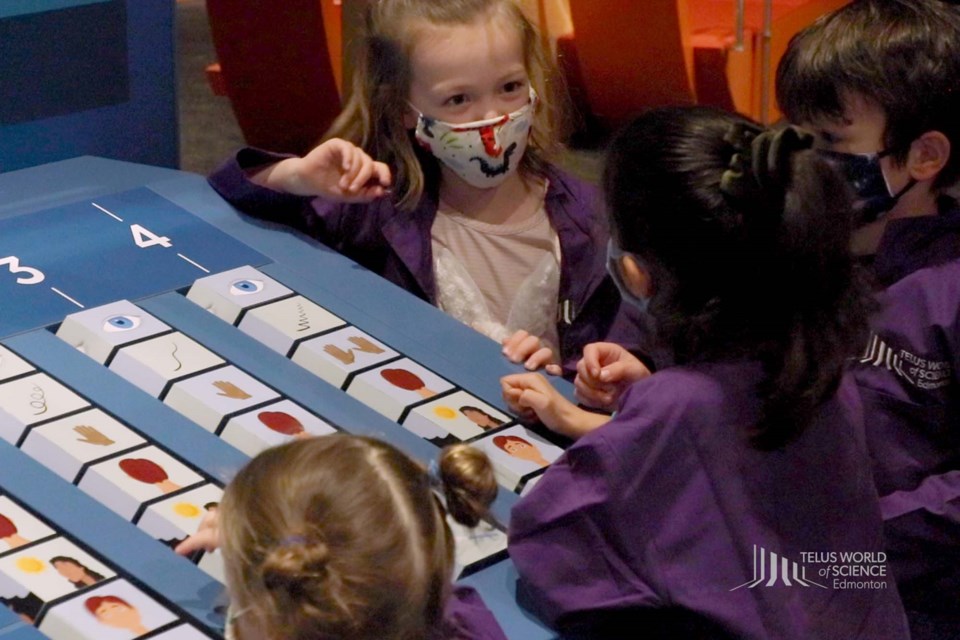The minute children walk into Telus World of Science’s new Health Zone lab, they put on white coats, safety glasses, and gloves. Science begins with a cheek cell experiment.
Cate Collins, a staff scientist who develops experiments for visitors, swabs the inside of a child’s mouth with a toothpick. Children are given the opportunity to put their cells on a slide and stain them with blue dye.
“If you didn’t stain them, they would be clear, and we wouldn’t be able to see them. Together we see leftover food, bacteria, and tooth amoeba,” said Collins adding, “We use a compound microscope with a magnification that enlarges them up to 40 times, and we get a good look at the samples on the slide.”
Adding a twist to the experiment, Collins pulls a hair from her head and places it under the microscope for size comparison.
“We were able to put four cheek cells across the width of the hair.”
Jennifer Bawden, senior manager of new galleries and research, believes the quirky science and technology experiments ignite children’s curiosity and inspire them to become researchers and scientists.
“Our lab is a wonderful space for our programming team to take them on. You put on the lab coat and goggles and be a scientist and work with equipment like a microscope to do skin tests. It’s what you do in first-year microbiology class,” said Bawden.
Started in 2014, Telus’s all-encompassing Aurora Project tagged at $40 million was designed to increase the science centre’s footprint, showcasing more contemporary topics such as the coronavirus. After a series of supply-chain disruptions, organizers unveiled the project’s first phase on Feb. 16.
It includes a new futuristic exterior wing, the Health Zone gallery and lab, an expanded gift shop, and the Indigenous Traditional Room used for educational purposes. An Indigenous outdoor medicine garden opens in the spring, while the Arctic Exhibition, the project’s final phase, is slated to open in September.
In addition to the lab, the 4,000-square-foot Health Zone showcases hands-on activities, challenges, videos, and panels. The gallery is divided into four colour-coded “pillars of health” explained Monica Roberts, director of science experience.
“The blue zone is about biology and human genetics. The orange zone looks at the choices people make from diet and exercise to stress and smoking. The green zone is about the environment — water, air quality, and things like the pandemic, while the red zone shows the structure supporting health care and the use of diagnostic tools,” said Roberts.
Visitors are encouraged to roam through different stations testing flexibility and strength, measuring and hearing a heartbeat, performing DNA extractions, viewing enlarged fingerprints under a scope, and scanning veins in hands and arms.
The most intriguing device which attracted a large crowd was the vein finder. At the opening, a school child placed his hand under a device emitting an eerie green light. The infrared light revealed a network of veins. A staffer explained hemoglobin (oxygen carrying protein) absorbs light and makes veins visible.
The Health Zone replaces a previous exhibit titled the Body Fantastic Gallery which opened in 2001. In creating the new gallery, planners wanted to go beyond mere physiology and anatomy.
“The Body Gallery had been wonderfully popular. We had it for 17 years. But the science wasn’t as dynamic around it. It’s the story of you, but this is a different take on the story, and as storytellers we like to explore new ideas all the time,” Bawden said.
The result is a gallery that is responsive to current health issues such as how bacteria and viruses enter the body, the COVID-pandemic, and the development of vaccines.
“Knowledge-wise I hope people will take away something about their health — something they didn’t know before. I hope you see your body in a different way, whether it’s learning about the microbes on your skin or taking a flexibility test. And there’s lots of skill-base experiences using microscopes and trying the scientific method. There’s no pop quiz when you leave this space, but I want you to be excited.”
Telus World of Science, located at 11211-142 Street, is open Wednesday to Sunday from 10 a.m. to 5 p.m.


